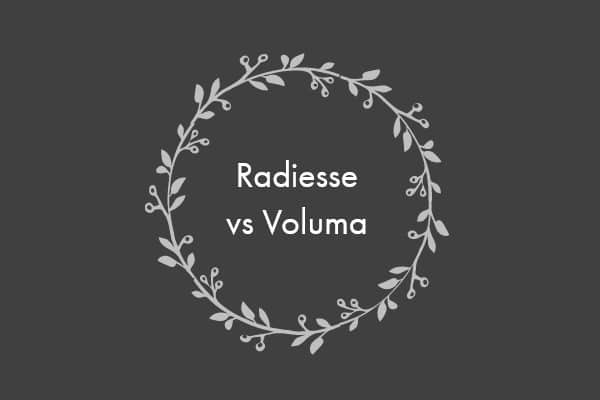Throughout the past decade, it’s been clear there has been a surge of innovative and novel cosmetic fillers, each addressing various aesthetic concerns. These cosmetic fillers promise an ideal correction for more skin types and dermal imperfections, while not requiring any permanent implants or surgical intervention(s). Even though most cosmetic fillers’ effects are only temporary, the subtle changes are immediate, natural, and bio-compatible.
Some of the popular cosmetic fillers that are approved by clinicians as well as the FDA are Juvederm Voluma and Radiesse. These two fillers are well-suited for being used to recontour and volumize to a person’s face without invoking any pyrogenic or immunogenic responses. Yet, just like how each individual is unique, each cosmetic filler has its own characteristics that makes them uniquely suitable for certain indications.
Getting to know Radiesse and Voluma
These two cosmetic fillers are approved for a similar indication: increase and augment the cheeks and the other mid-to-lower face region. The major difference lies in the composition of these fillers.
Radiesse is a cosmetic implant that uses calcium hydroxylapatite (CaHA), a biocompatible material. This gel is produced biosynthetic microspheres, which are suspended in a glycerin, carboxymethylcellulose, and sterile water for injection gel carrier. This material is highly tolerable when injected in the body because its composition is similar to human calcium structures, such as the teeth. It is injected intradermally.
Juvederm Voluma is a sterile, cohesive, clear, and hydrating hyaluronic acid-based cosmetic filler. This ingredient is more widely used in cosmetic fillers, as it can provide skin rejuvenation, volumizing, and tolerability within the dermal layer. For Voluma, the hyaluronic acid (HA) is a produce of the biofermentation of equine streptococci. The cohesion and viscosity of the gel is a result of the combining of 90% HA with high molecular weight and 10% HA with low molecular weight via Vycross technology and cross-linking. It is also injected intradermally.
Hyaluronic acid vs CaHA
Both materials function differently when it comes to correcting aging-related volume loss. HA is more familiar to the body, as it is commonly found in the body. The concentration depletes as one gets older than 21. Replacing the lost volume with new sterile and biocompatible HA seems logical, as it can affix itself to neighboring tissues with low complications. This sugar molecule has a high affinity to water molecules; indeed, it can bind to and retain almost 1,000 times its own weight in water. Other than that, it also communicates with other cells in the body like fibroblasts to stimulate neocollagenesis.
CaHA, on the other hand, is not explicitly found within the body. However, it has s similar composition to human bones. When CaHA particles are deposited into the soft tissue, it attaches itself to fibroblasts and stimulates collagen growth. The gel carrier provides temporary volume to the area while a firm and thick layer of new collagen fibers is developed.
Both cosmetic fillers provide temporary correction due to the impermanence of the filler in the body. The HA in Voluma can last for up to 18 months due to its high molecular weight and concentration. The strong cross-linkage of the HA allows it to withstand any external pressure and maintain the shape of the facial contour until it gradually dissolves within the neighboring tissues.
CaHA, however, works in a different manner. It mimics the surrounding extracellular matrix to avoid any calcification or migration. Phagocytes will eliminate CaHA 23 months after the injection and metabolize it into phosphate and calcium ions that are safe in the body. In return, the effects of Radiesse are preserved by the new collagenic network. In summary, this cosmetic filler encourages the skin’s natural collagen production to plump up the face.
Result and its longevity
Part of the appeal of these two fillers is that both procedures take only an average of half an hour to complete and require minimal downtime. Both can deliver a subtle or prominent volume lift to the midface area, especially the region of the cheeks. Voluma can be injected into the deeper layer of the dermis, including the upper periosteum near the bone, and the subcutaneous region. Radiesse, too, can be injected in the deep dermis layer so as to create an in-depth collagen fiber network.
Like most cosmetic fillers, Radiesse and Voluma can provide long-lasting results. Voluma has been very successful in clinical and post-commercial studies. In fact, patients have, in some cases, had the effects of their Voluma filler last for two years with optimal treatment. It is also possible to prolong the effect by repeating the treatment within two years at a fraction of the product volume.
Radiesse’s dramatic improvement in the face can be sustained for one to two years. As discussed before, this duration is based on the meshwork of the new collagenic layer whose creation Radiesse stimulates. The radiant and plump look that Radiesse brings about is a result of the skin’s own fibroblastic stimulation.
Complications and aftercare
Patients must be fully aware that both products, despite being non-invasive, can elicit minor side effects. These include mild redness, tenderness, irritation, and swelling at the targeted area(s). With appropriate aftercare methods, such as reducing exposure to the sun and heated conditions, not applying pressure onto the treated area(s), and not performing any strenuous exercises 24 hours after the injection, these effects can be resolved within 14 days.
Voluma’s major advantage, however, is that it is reversible. Indeed, the enzyme hyaluronidase can make HA dissolve, and it can be used in cases of overcorrection, swelling, bruising, and asymmetrical placement of the gel.
On the other hand, the irreversible, although temporary, nature of Radiesse means that there is no simple way to remove the filler once it is implanted until it is dissolved. The initial lump(s) or swelling(s) that can come about after a Radiesse treatment is actually the remnants of the gel carrier, which will dissipate within four weeks. Patients do not need to worry about misshapen lumps, as the new collagenic layer’s growth is natural and organic and will conform to the facial contours.
Voluma is available in a 2m disposable syringe with a Luer lock fitting and may contain premixed lidocaine for the comfort of the patients. Radiesse is distributed in 1.5ml disposable syringe that can be reused on the same patient within the span of three months.
Conclusion
Both fillers are excellent for at providing high quality-and natural-looking augmentations. While they can be used on their own, some clinicians have also suggested combining both fillers for a more outstanding result, especially when it comes to larger surface areas. For a more satisfactory and competent workflow, the injector or the practitioner needs to understand the chemical composition of these two products and have a strong patient-selection practice. With these necessities in mind, the injector or practitioner patients can help their patients achieve their desired cosmetic goals.





















